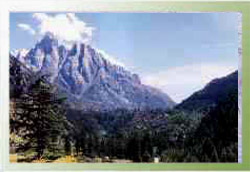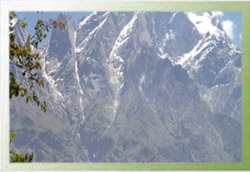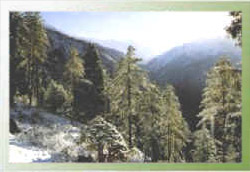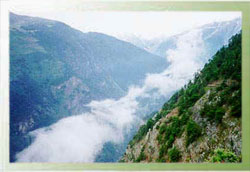|
 Is a district of Himachal Pradesh, situated between Shimla district and the Tibetan border. The region was derestricted and opened up to tourism in1991. The early history of Kinnaur is sparsely recorded. Perhaps the most remarkable fact is that the region was (un-like nearby Lahul and Spiti and Ladakh) not invaded by forces of west Tibet. Kinnaur is bounded to the north by the formidable Zanskar range that provides the border with Tibet. To the south, the main Himalayan range forms the backdrop of the region including the impressive Kinnaur Kailash range with the peaks Kinnaur Kailash 6050m., Jorkanden 6473m. and Phawarang 6349m. that provides an effective barrier to the monsoon rains. Is a district of Himachal Pradesh, situated between Shimla district and the Tibetan border. The region was derestricted and opened up to tourism in1991. The early history of Kinnaur is sparsely recorded. Perhaps the most remarkable fact is that the region was (un-like nearby Lahul and Spiti and Ladakh) not invaded by forces of west Tibet. Kinnaur is bounded to the north by the formidable Zanskar range that provides the border with Tibet. To the south, the main Himalayan range forms the backdrop of the region including the impressive Kinnaur Kailash range with the peaks Kinnaur Kailash 6050m., Jorkanden 6473m. and Phawarang 6349m. that provides an effective barrier to the monsoon rains.
 Lahaul & Spiti Lahaul & Spiti
The largest district in Himachal Pradesh, is a vast area of high mountains and narrow valleys bounded by Ladakh and Tibet to the north, Kinnaur to the east and Kulu valley to the south. Lahaul is often regarded as a midway point en-route to Leh and the Indus valley. It does, however, have much to offer. Spiti has only recently been open to foreign tourists attracted to the isolated Buddhist Gompas and Villages.
Lahual consist of two regions – upper Lahual which includes the Chandra and Bhaga valleys and lower Lahual which comprises the region of Chinab valley bellow the confluence of the Chandra and Bhaga rivers. Spiti is located to the east of Lahual and comprises the popular Spiti valley.
 Entry
Formalities Entry
Formalities
Foreign nationals can travel with permits issued by District Magistrate, Sub District Magistrate, Additional Deputy Commissioner's, only when they are
traveling in a group of four (4) or more persons.
The permits can be obtained on presenting the following documents, viz. i) Three passport size photographs, ii) Police verification from home town or any other equivalent documents like passport, driving license etc., which can establish the identification of the applicant. Foreigners are required to present an itinerary and introduction by a recognized travel agent. The tourists are advised to get their documents verified at the checkpoints at Chitkul, Lippa, Khud (Kinnaur) and Kaza (Spiti).
How To Get There
Air
Airports at Shimla and Kulu are connected with Delhi by air.
Rail
The nearest railhead Kalka (between Chandigarh – Shimla and Jogindar near Mandi before Kulu connected with the major cities of the country.
Road
Connected by black top road "however" during the monsoon the road do get blocked some times.
In and around
Kinnaur Recong Peo
Kinnaur Recong Peo up a side road from the main thoroughfare through Kinnaur are the two main towns of Kalpa, the former capital, and Recongpeo, the current capital of Kinnaur. Both places have the most stupendous settings in probably all of Himachal Pradesh – anywhere up the road will give you increadable views of the mighty Kinnaur Kailash mountain, among several others, at around 6000m.
Kinnaur Kalchakra celestial palace
A lovely, brightly coloured gompa, the Kinnaur Kalchakra celestial palace, is about a 20 minut steep walk above the village. Inaurgrated by HH Dailai Lama in 1992, the gompa itself is not the major attraction – there is a huge outdoor Buddha statue, in an area over run by apple orchards, and facing the mighty Kinnaur Kailash mountain.
Kalpa
Known a Chini when it was the main town in Kinnaur, Kalpa is the legendry winter home of Shiva; during the winter, the god is said to retire to his Himalayan home here and indulge his passion for Hashish. Kalpa is atiny collectin of narrow lanes, 7 km. and 600m. higher in altitude up a windy road from the Recong Peo.
Sangla Valley (Alpine meadows)
 Sangla Valley (Alpine meadows) is also called the Baspa Valley because it follows the 95 km long Baspa River. The valley is a remote area, full of wildlife and dominated by spectacular mountains. Sangla village, has a temple dedicated to Nagesh. From the village, you can trek about 2 km to Kamru which has a five storey, wooden fort. Kamru is a former capital of the Buishahr empire which once ruled Kinnaur. The 44 km valley road finishes at Chitkul, where there are three temples, dedicated to the goddess Mathi, built about 500 years ago. Sangla Valley (Alpine meadows) is also called the Baspa Valley because it follows the 95 km long Baspa River. The valley is a remote area, full of wildlife and dominated by spectacular mountains. Sangla village, has a temple dedicated to Nagesh. From the village, you can trek about 2 km to Kamru which has a five storey, wooden fort. Kamru is a former capital of the Buishahr empire which once ruled Kinnaur. The 44 km valley road finishes at Chitkul, where there are three temples, dedicated to the goddess Mathi, built about 500 years ago.
Ribba
This pleasant little place is famous for its 1000 year
old gompa and angoori grape wine.
Moorang
Moorang also has a gompa, with renowned sculptures and
carvings. The village of Phu is the usual place for
buses to stop and for passengers to eagerly devour large
serves of dhal, rice and vegetables. At Khabo, the
mighty Spiti river fades out and is replaced by the
dominant Sutlej river. About 10 km further on, Kha is
the starting point for a one km walk to the Tilasangh
Gompa.
Spiti and Lahul Kaza
is the major transport hub along the vast eastern
part of Himachal Pradesh, and is the administrative
centre of the subdistrict of Spiti. Kaza can be divided
into two areas. The 'old town', south of the current bus
stand, is a maze of little shops, hotels and houses. The
'new town', a collection of government buildings,
including the district Magistrate's office is over the
creek.
Dankar gompa
Dankar gompa built nearly 1000 years ago, Dankar
Gompa has a spectacular rocky setting. Once the site of
the capital of Spiti, and thena ajil, the gompa has over
150 monks, some outstanding thangkas (usually locked
away), sculptures, frescoes and a statue of Dhyan Buddha
(thinking Buddha). Some of the gompa was destroyed
during a particularly harsh winter in 1989.
Lhalung gompa
Lhalung gompa which is not located on most maps. Lhalung
gompa is over 1000 years old – reputedly for its wood
carvings and isolation.
Ki Gompa and Kibber Ki
The oldest and largest gompa in Spiti, about 14 km from
Kaza, was built by Ringchen Zangpo and belongs to the
Gelukpa order. The gompa was invaded three times in the
19th century by Ladakhis, Dogras and Sikhs. It was
damaged by fire, and was partially destroyed by an
earthquake in 1975. About 11 km from Ki village is the
small village of Kibber, also known as Khyipur. It
claims to be the highest village in the world, at 4250m
although Gete (4270m), another village about seven km
east of Ki, has a better claim to this honour. Kibber
was a part of the overland salt trade centuries ago, and
is a pretty little place.
Pin Valley
Starts just south of Dhankar, along the Pin River.
Thevalley is reputedly famous for its wildlife – often
referred to as the "Land of Ibex & Snow Leopard", but
hardly see little else but Marmots. Along the valley
there are several gompas following different forms of
Buddhism to that normaly found in Lahual and Spiti. The
Village of Gulling has a gompa, which belongs to the
Nyingmapa order, where you can stay. The most important
gompa in the valley is the 600-year- old gompa at Kungri,
a few km from the main road down the valley.
Tabo gompa
Tabo gompa is one of the most important in all of the
Tibetan Buddhist World, and is planned as the place
where the current HH Dalai Lama will retire. It was
built in 996 AD by the great translator, Ringchen Zangpo,
who brough artist fromKashmir to decorate the gompa.
Designed in a western Tibetan Style, the gompa houses
impressive murals and sculptures. There are eight
temples in the complex, all at ground level and some
dating from the 10th century.
Lahual Keylong
Located on a fertile plain, Keylong, the capital of
Lahual and Spiti, is a reasonable place to break-up the
journey from Leh to Manali, to base your-self for day
trips to near by gompas.
Kardong gompa
The 900 year old gompa at Khadong, formerly a capital of
Lahual is only 4km. from Keylong. Of the Gylukpa order,
this is the largest gompa in the area with about 30
Lamas and Chumos (Nuns). There are good frescoes, some
old prayer drums, alarge Buddha statue and a famous
library of ancient scriptures.
Shashur gompa
3 km. from Keylong, dedicated to Zanskari Lama, it was
built in 16 century and is of the Gylukpa order. The
five meter thanka is famous in the region. An, annual
festival, held every June or July, is renowned for the
mask dances preformed by the Lamas.
Tayl gompa
6 km. from Keylong, in the village of Santingiri, is
Tayal gompa, which means "chosen place" in Tibetan. The
300 year old gompa has a library, a fine collection of
thankas and four meter high statue of Padamasambava.
|



